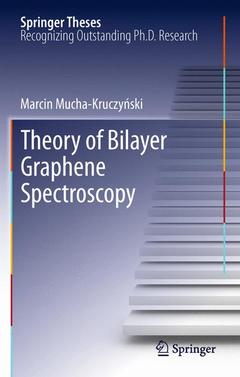Description
Theory of Bilayer Graphene Spectroscopy, 2013
Springer Theses Series
Language: English
Subjects for Theory of Bilayer Graphene Spectroscopy:
Theory of Bilayer Graphene Spectroscopy
Publication date: 10-2014
86 p. · 15.5x23.5 cm · Paperback
Publication date: 10-2014
86 p. · 15.5x23.5 cm · Paperback
Theory of bilayer graphene spectroscopy
Publication date: 09-2012
86 p. · 15.5x23.5 cm · Hardback
Publication date: 09-2012
86 p. · 15.5x23.5 cm · Hardback
Description
/li>Contents
/li>Comment
/li>
This thesis presents the theory of three key elements of optical spectroscopy of the electronic excitations in bilayer graphene: angle-resolved photoemission spectroscopy (ARPES), visible range Raman spectroscopy, and far-infrared (FIR) magneto-spectroscopy. Bilayer graphene (BLG) is an atomic two-dimensional crystal consisting of two honeycomb monolayers of carbon, arranged according to Bernal stacking. The unperturbed BLG has a unique band structure, which features chiral states of electrons with a characteristic Berry phase of 2$\pi$, and it has versatile properties which can be controlled by an externally applied transverse electric field and strain. It is shown in this work how ARPES of BLG can be used to obtain direct information about the chirality of electron states in the crystal. The author goes on to describe the influence of the interlayer asymmetry, which opens a gap in BLG, on ARPES and on FIR spectra in a strong magnetic field. Finally, he presents a comprehensive theory of inelastic Raman scattering resulting in the electron-hole excitations in bilayer graphene, at zero and quantizing magnetic fields. This predicts their polarization properties and peculiar selection rules in terms of the inter-Landau-level transitions.
The Tight-Binding Approach and the Resulting Electronic Structure.- Angle-Resolved Photoemission Spectroscopy.- Magneto-Optical Spectroscopy.- Electronic Raman Spectroscopy.
Nominated as an outstanding contribution by the University of Lancaster Investigates a novel material at the focus of much research interest Valuable theoretical results show what different spectroscopic techniques can reveal about graphene Includes supplementary material: sn.pub/extras
© 2024 LAVOISIER S.A.S.

